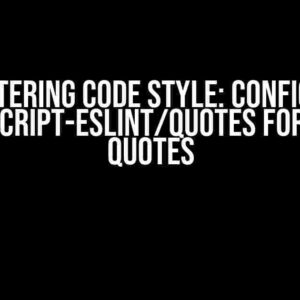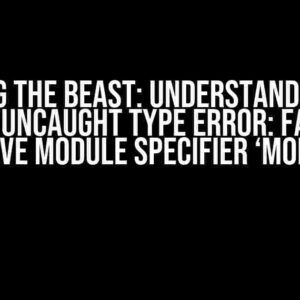Have you ever encountered a frustrating situation where your handle click event doesn’t work as expected when resetting a field to empty? You’re not alone! This issue is more common than you think, and it’s often due to a simple misunderstanding of how event handling and form resetting work in HTML and JavaScript.
What’s the Problem?
When you reset a form field to empty using JavaScript, you might expect the handle click event to work as usual. However, in many cases, the event doesn’t fire when the field is reset to empty. This can be puzzling, especially if you’ve written the code correctly.
The Reason Behind the Issue
The main reason for this issue is that when you reset a form field to empty, the browser doesn’t trigger a change event. This means that the event listener attached to the handle click event won’t be triggered either.
Here’s an example of how this might look in code:
// Assuming 'myField' is the input field and 'myButton' is the button
document.getElementById('myButton').addEventListener('click', function() {
// Reset the field to empty
document.getElementById('myField').value = '';
// Handle click event logic here
console.log('Handle click event fired!');
});
Solving the Problem
So, how do you get the handle click event to work when resetting a field to empty? There are a few approaches you can take:
Method 1: Use the ‘input’ Event Instead
One solution is to use the ‘input’ event instead of the ‘click’ event. The ‘input’ event is triggered whenever the user types something in the input field or when the value of the field changes programmatically.
document.getElementById('myField').addEventListener('input', function() {
// Handle input event logic here
console.log('Input event fired!');
// You can also check if the field is empty
if (this.value === '') {
console.log('Field is empty!');
}
});
Method 2: Trigger the Event Manually
Another approach is to trigger the event manually using the ‘dispatchEvent’ method. This method allows you to create and dispatch a synthetic event to an element.
document.getElementById('myButton').addEventListener('click', function() {
// Reset the field to empty
document.getElementById('myField').value = '';
// Create a synthetic click event
var event = new Event('input', { bubbles: true });
// Dispatch the event to the field
document.getElementById('myField').dispatchEvent(event);
console.log('Handle click event fired!');
});
Method 3: Use a Timeout
A third solution is to use a timeout to delay the execution of the event handler until the field has been reset to empty.
document.getElementById('myButton').addEventListener('click', function() {
// Reset the field to empty
document.getElementById('myField').value = '';
// Use a timeout to delay the execution of the event handler
setTimeout(function() {
console.log('Handle click event fired!');
}, 0);
});
Conclusion
In conclusion, the issue of the handle click event not working when resetting a field to empty is a common problem that can be solved using one of the methods outlined above. By understanding how event handling and form resetting work in HTML and JavaScript, you can create robust and user-friendly interfaces that respond as expected.
Best Practices
Here are some best practices to keep in mind when working with event handling and form resetting:
- Always use the ‘input’ event instead of the ‘click’ event when working with input fields.
- Trigger events manually using the ‘dispatchEvent’ method when necessary.
- Use timeouts judiciously to delay the execution of event handlers.
- Test your code thoroughly to ensure that it works as expected in different scenarios.
| Method | Description | Example Code |
|---|---|---|
| Using the ‘input’ event | Triggered whenever the user types something in the input field or when the value of the field changes programmatically. | document.getElementById('myField').addEventListener('input', function() {...}); |
| Triggering the event manually | Creates and dispatches a synthetic event to an element. | var event = new Event('input', { bubbles: true }); document.getElementById('myField').dispatchEvent(event); |
| Using a timeout | Delays the execution of the event handler until the field has been reset to empty. | setTimeout(function() {...}, 0); |
By following these best practices and using the methods outlined above, you can create robust and user-friendly interfaces that respond as expected, even when resetting fields to empty.
Frequently Asked Questions
-
Why doesn’t the handle click event work when resetting a field to empty?
The handle click event doesn’t work because the browser doesn’t trigger a change event when resetting a form field to empty.
-
Can I use the ‘click’ event instead of the ‘input’ event?
No, you should use the ‘input’ event instead of the ‘click’ event when working with input fields. The ‘input’ event is triggered whenever the user types something in the input field or when the value of the field changes programmatically.
-
How do I trigger the event manually?
You can trigger the event manually using the ‘dispatchEvent’ method. This method allows you to create and dispatch a synthetic event to an element.
-
What’s the best approach to solving this issue?
The best approach depends on your specific use case. However, using the ‘input’ event is often the most reliable and efficient solution.
By understanding the reasons behind the issue and using the methods outlined above, you can create robust and user-friendly interfaces that respond as expected, even when resetting fields to empty.
Frequently Asked Question
Stuck on a clicking conundrum? Don’t worry, we’ve got the answers to get your handle clicking smoothly again!
Why does my handle click not work when resetting the field to empty?
This might happen because the handle click event is tied to the field’s value being changed. When you reset the field to empty, the value doesn’t actually change, so the click event isn’t triggered. To fix this, try resetting the field to a placeholder value (like a single space) instead of empty.
Is this a bug or a feature?
This behavior is actually a feature! It’s designed to prevent accidental clicks when the field is empty. But don’t worry, there are workarounds (like the one mentioned above) to get your handle clicking smoothly again.
Can I use JavaScript to fix this?
JavaScript to the rescue! Yes, you can use JavaScript to trigger the click event manually when the field is reset to empty. Just make sure to add a conditional check to avoid infinite loops.
Are there any alternative solutions?
Yes! Instead of resetting the field to empty, you could clear the field’s value and then focus on the field to trigger the click event. This way, you can avoid the issue altogether.
What if I’m using a framework or library?
If you’re using a framework or library, make sure to check their documentation for specific guidance on handling handle clicks and field resets. They might have built-in solutions or workarounds for this common issue.




